
King crabs are a taxon of decapod crustaceans that are chiefly found in cold seas. Because of their large size and the taste of their meat, many species are widely caught and sold as food with the most common being the red king crab.
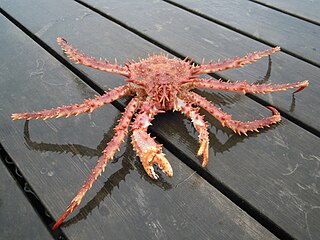
Lithodes maja, the Norway king crab or northern stone crab, is a species of king crab which occurs in colder North Atlantic waters off Europe and North America. It is found along the entire coast of Norway, including Svalbard, ranging south into the North Sea and Kattegat, the northern half of the British Isles, and around the Faroe Islands, Iceland, and off south-eastern Greenland. In the West Atlantic, it ranges from the Davis Strait between Greenland and Canada south to The Carolinas in the United States.

Scotoplanes is a genus of deep-sea sea cucumbers of the family Elpidiidae. Its species are commonly known as sea pigs.

Lithodes santolla, also known as the southern king crab, Chilean king crab or centolla, is a species of king crab, found off southern South America including the offshore Falkland Islands. On the Pacific side, it is found in Chile from Talcahuano to Cape Horn. On the Atlantic side, it is found off Argentina and Uruguay. It lives in the benthic zone at depths of 0–700 m (0–2,300 ft), with Uruguayan records being exclusively from great depths. In Chile, it mostly lives at depths to 150 m (490 ft), but south of 40° S it can be found to 600 m (2,000 ft). It is a large crab that can reach up to 19 cm (7.5 in) in carapace length, and it is the target of commercial fishing.
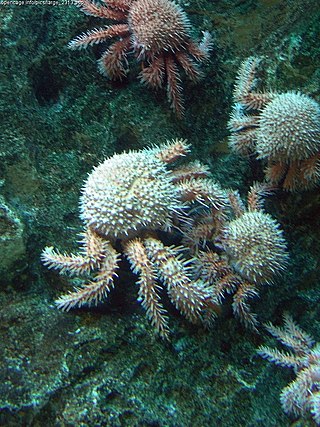
Paralomis histrix is a species of king crab, family Lithodidae. It lives at a depth of 180–400 m (590–1,310 ft) in Tokyo Bay, Enshunada and through to Kyūshū. It has few predators because of its size and spiky carapace. It is sometimes kept in public aquariums and is occasionally referred to as the porcupine crab, a name otherwise used for Neolithodes grimaldii.

Lithodes is a genus of king crabs. Today there are about 30 recognized species, but others formerly included in this genus have been moved to Neolithodes and Paralomis. They are found in oceans around the world, ranging from shallow to deep waters, but mostly at depths of 100–1,000 m (300–3,300 ft). They are restricted to relatively cold waters, meaning that they only occur at high depths at low latitudes, but some species also shallower at high latitudes. They are medium to large crabs, and some species are or were targeted by fisheries.
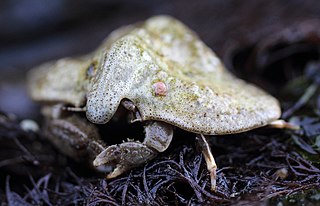
Cryptolithodes typicus, often referred to as the butterfly crab or the turtle crab, is a species of lithodid crustacean native to coastal regions of the northeastern Pacific Ocean, ranging from Amchitka Island, Alaska to Santa Rosa Island, California.
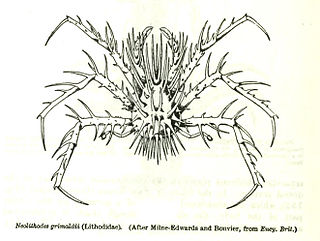
Neolithodes grimaldii, the porcupine crab, is a species of king crab in the family Lithodidae. This large red crab is found in cold deep waters in the North Atlantic and often caught as a bycatch in fisheries for Greenland turbot. As suggested by its common name, the carapace and legs are covered in long spines.
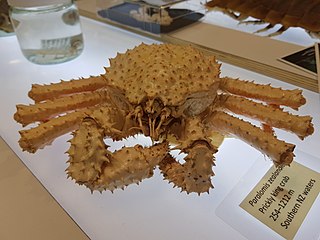
Paralomis zealandica, also known as the prickly king crab, is a species of king crab which lives at a depth of 254–1,212 m (833–3,976 ft) in New Zealand. It has spiky carapace. The scientific name of the species was first validly published in 1971 by Dawson & Yaldwyn. P. zealandica can be distinguished from other species in New Zealand waters by its thick covering of strong upright spines all over, including on its abdomen and along its legs and claws. The rostrum has three short, strong and sharp spines. It is the most prominent species of Paralomis in New Zealand.
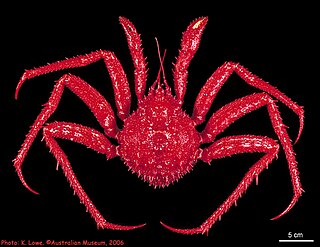
Neolithodes flindersi is a species of king crab found in southeastern Australia. They have been found at depths of 887–1,333 metres (2,910–4,373 ft) but typically appear from 950–1,050 metres (3,120–3,440 ft). They most closely resemble Neolithodes brodiei and Neolithodes nipponensis.

Neolithodes agassizii is a species of king crab native to the Western Atlantic. They live at depths of 200–1,900 metres (660–6,230 ft), and have been found as far south as Rio de Janeiro, as far north as latitude 36°, and near the Equator. It has been found in the southwestern Caribbean Sea as well as the Gulf of Mexico.

Neolithodes brodiei is a species of king crab which is native to New Zealand and its adjacent waters. It lives at a depth of 500–1,240 metres (1,640–4,070 ft) but is typically found within a depth of 950–1,150 metres (3,120–3,770 ft). It has a deep-red colour, and its carapace has many small spinules along with larger spines. It is classified as "Not Threatened" by the New Zealand Department of Conservation.
Neolithodes vinogradovi is a species of king crab whose native habitat ranges from the Arabian Sea to the Coral Sea.
Neolithodes asperrimus is a species of king crab native to the coast of Africa. It has been found in South Africa and Mauritania at depths of 997–1,862 metres (3,271–6,109 ft), and Neolithodes aff. asperrimus has been found in Madagascar, Réunion, and the South Region of Brazil.
Neolithodes capensis is a species of king crab which is found in the Southern Ocean and the western Indian Ocean. It has been found to a depth of 660–3,200 metres (2,170–10,500 ft).

Neolithodes diomedeae is a species of king crab which is found in the eastern Pacific Ocean, the southwestern Atlantic Ocean, and the Bellingshausen and Scotia Seas in the Southern Ocean. They occur from 200 to 2,454 m.
Neolithodes nipponensis is a species of king crab which is found in Japan and Taiwan. It has been found at depths from 200–1,752 metres (656–5,748 ft).
Neolithodes duhameli is a species of king crab which is found in the Crozet Islands in the southwestern Indian Ocean from a depth of 620–1,500 metres (2,030–4,920 ft).
Lithodes longispina is a species of king crab. It has been found in Japan and Taiwan. Before 2010, its reach was thought to be much greater than presently understood, such as Australia, New Zealand, and Guam. It has also allegedly been sighted in the Northwestern Hawaiian Islands.


















